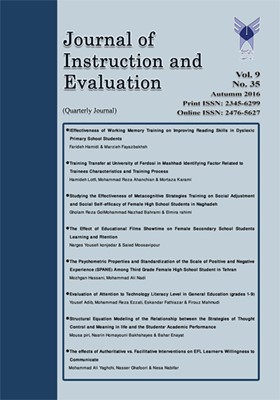The Effects of Authoritative vs. Facilitative Interventions on EFL Learnersʼ Willingness to Communicate
Subject Areas : Educational PsychologyMohammad Ali Yaghchi 1 , Nasser Ghafoori 2 , Nesa Nabifar 3
1 - Department of English, Tabriz branch, Islamic Azad University, Tabriz, Iran
2 - Department of English, Tabriz branch, Islamic Azad University, Tabriz, Iran
3 - Department of English, Tabriz branch, Islamic Azad University, Tabriz, Iran
Keywords: EFL learners, Willingness to communicate, Authoritative Intervention, Facilitative Intervention,
Abstract :
The present study sought to investigate the effects of employing the intervention provision framework put forward by John Heron, entitled Six-Category Intervention Analysis, on EFL learners' willingness to communicate. This model of intervention provision, having its genesis in clinical supervision, can regulate the verbal behavior and actual sentences used by teachers to intervene in language learning contexts. The Preliminary English Test (PET) as an English language proficiency test was administered to 60 participants. Based on the results obtained, 36 participants were selected and assigned to two groups of 18. The first group was authoritative intervention group in which the teacher suggested what had to be done, provided information, or confronted the learners. The second group was facilitative intervention, in which the teacher drew out ideas, solutions, or self-confidence. The participants in both groups completed Willingness to Communicate questionnaire before and after the treatment, as well as in the follow-up period. The findings indicated that the application of Six-Category Intervention Analysis brought about significant changes in the performance of the facilitative group that outperformed the authoritative intervention group.This research could carry some important implications for all stakeholders in the realm of foreign language teaching
References
Alemi, M., Tajeddin, Z. & Mesbah Z. (2013). Willingness to communicate in L2 English: Impact of Learner Variables. Journal of Research in Applied Linguistics, 4 (1), 42-61.
Ashmore, R. (1999). Heron’s intervention framework: An introduction and critique. Mental Health Nursing, 19(1), 24-27.
Cao, Y., & Philip J. (2006). Interactional context and willingness to communicate: a comparison of behavior in whole class, group and dyadic interaction. System, 34 (2006), 480-493.
Chambers, M., & Long, A. (1995). Supportive clinical supervision: A crucible for personal and professional change. Journal of Psychiatric and Mental Health Nursing, 2(5), 311-316. http://dx.doi.org/10.1111/j.1365-2850.1995.tb00097.x
Cutcliffe, J., & Epling, M. (1997). An exploration of the use of John Heron’s confronting interventions in clinical supervision: Case studies from practice. Psychiatric Care, 4(4), 174-180.
de Bot, K., Lowie, W., & Verspoor, M. (2005). Second language acquisition: An advanced resource book. USA: Routledge.
Dornyei, Z., & Murphey, T. (2003). Group dynamics in the language classroom. Cambridge: Cambridge University Press. http://dx.doi.org/10.1017/CBO9780511667138
Edwards, A. D., & Westgate, D. P. G. (1987). Investigating classroom talk. London: The Falmer Press.
Ellis, R. (1999). (Ed.). Learning a second language through interaction. Philadeliphia: John Benjamins.
Ellis, R. (2008). The study of second language acquisition(2nd ed.).Oxford: OUP.
Farrell, T. S. C. (2002). Classroom discourse: An introduction. Singapore: National Institute of Education, Nanyang Technological University.
Fowler, J. (1996). Clinical supervision: What do you do after you say hello? British Journal of Nursing, 5(6), 382-385. http://dx.doi.org/10.12968/bjon.1996.5.6.382
Galadja, D. (2012). Teacher’s zone of action in facilitating group dynamics. LINGVARM ARENA, 3, 89-101.
Heron, J. (1976). A six-category intervention analysis. British Journal of Guidance and Counseling, 4(2), 143-155. http://dx.doi.org/10.1080/03069887608256308
Heron, J. (2001). Helping the client: A creative practical guide (5th ed.). London: Sage Publication.
Lai, W. (2012). Concept-based foreign language pedagogy: Teaching the Chinese temporal system (Unpublished Ph.D. dissertation, The Pennsylvania State University, University Park, PA).
Lantolf, J. P., & Thorne, S. (2006). Sociocultural theory and the genesis of second language development. Oxford: Oxford University Press. www.ccsenet.org/ijel International Journal of English Linguistics, 6(1), 2016 98.
Larsen-Freeman, D. (1997). Chaos/complexity science and second language acquisition. Applied Linguistics, 18(2), 141-165.
Larsen-Freeman, D., & Cameron, L. (2008). Complex systems and applied linguistics. Oxford: Oxford University Press.
Lengeling, M. M. (2011). Past, present, and future of second language acquisition: An interview with Rod Ellis. MEXTESOL Journal, 35(1), 1-7.
MacIntyre, P.D., Burns, C., & Jessome, A. (2011). Ambivalence about communicating in a second language: a qualitative study of French immersion learners' willingness to communicate. The Modern Language Journal, 95 (1) (2011), 81-96.
Maggioli, G. E. (2012). Teaching language teachers: Scaffolding professional learning. UK: Rowman and Littlefield.
Negueruela, E., & Lantolf, J. P. (2006). Concept-based pedagogy and the acquisition of L2 Spanish. In R. M. Salaberry & B. A. Lafford (Eds.), The art of teaching Spanish: Second language acquisition from research to praxis(pp. 79-102). Washington: Georgetown University Press.
Sloan, G., & Watson, H. (2001). John Heron’s Six Category Intervention Analysis: Towards understanding interpersonal relations and progressing the delivery of clinical supervision for mental health nursing in the United Kingdom. Journal of Advanced Nursing, 36(2), 206-214. http://dx.doi.org/10.1046/j.1365-2648.2001.01961.x
Sloan, G., & Watson, H. (2002). Clinical supervision models for nursing: Structure, research and limitations. Nursing Standard, 17(4), 41-46. http://dx.doi.org/10.7748/ns2002.10.17.4.41.c3279
Swain, M. (2000). The output hypothesis and beyond: Mediating acquisition through collaborative dialogue. In J. Lantolf (Ed.), Socio-cultural theory and second language learning (pp. 97-114). Oxford: Oxford University Press.
Van Compernolle, R. A. (2011). Developing second language sociopragmatic knowledge through concept-based instruction: A mictrogenetic case study. Journal of pragmatics, 43, 3268-3283. doi:10.1016/ j.pragma.2011.06.009
Vygotsky, L. S. (1986). Thought and language. Cambridge, MA: MIT Press.
Wen, W.P. and Clement, R. (2003) A Chinese conceptualization of willingness to communicate in ESL. Language, Culture and Curriculum, 16 (1) (2003), 18-38.
Widdowson, H. G. (1990). Aspects of language teaching. Oxford: Oxford University Press.
_||_

